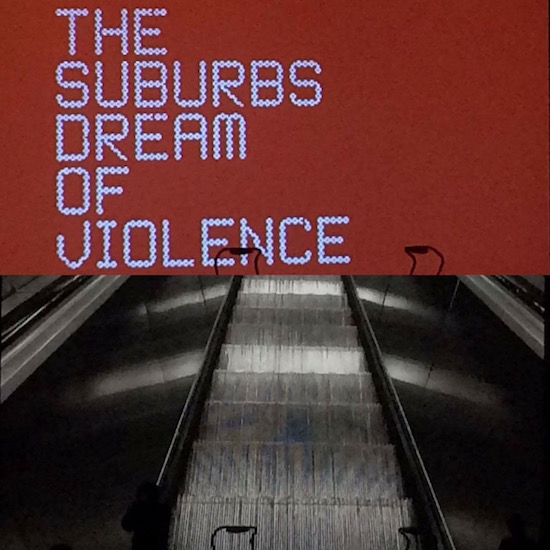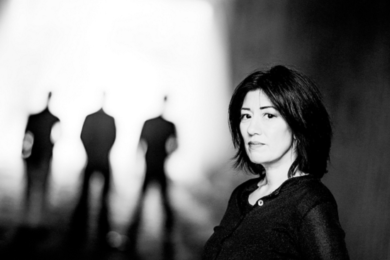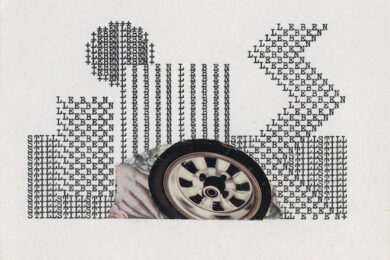And so, going the way of all things flesh and Unflesh, live music is dead.
In a recent interview on this website, Canadian artist Kara-Lis Coverdale explained her process for – and the general impossibility of – playing live, “like asking an architect to build a building in front of someone’s eyes.” It’s a contentious argument, and one that will undoubtedly raise the eyebrows and loosen the eyeballs of some. But, right or wrong in its intent, as divisive statements so often do, it alludes to something beyond itself: in this case to a wider malaise with the traditional format of live music. Something that, between various projects and gigs, finally crystalised in an hour-long show by Gazelle Twin at this year’s Sonár Festival in Barcelona. A performance that was quite literally breathtaking.
Given the festival’s penchant not just for electronic music, but also for the forms of technology themselves – hosting talks and workshops by day, skirting the outer limits of the contemporary and the extra-contemporary – it’s perhaps no surprise that the point should be made here in a dark auditorium in the Catalan capital. But before the question is answered, it has to be asked: “What (and who) is live music for?”
There’s an argument to be made that the purpose of live music is as a kind of communion – something bordering on mass hysteria; that the desire of the audience isn’t so much to experience the music itself but to share the experience of being in the presence of music with likeminded individuals as part of some wider event. A Toronto Blessing for the secular listener. But this is really just an extension of the act of listening to the album alone in the comfort of your own home, and a reference point for Coverdale’s reluctance: this particular brand of live music experience requires near-perfection – replication of familiar detail, of the known quantity, to invoke a familiar response.
It’s a double-edged sword: on the one hand, the near-impossibility for most artists (especially those in the lower and middle echelons) to replicate material they’ve spent months on in a studio environment in a considerably more limited performance setting is one reason that live music is so frequently disappointing for both artist and listener. On the other, when that perfection is achieved, it can be cold – hollow, even. It’s undue stress and undue expectation, rarely to the benefit of those on-stage or those staring up at it.
The alternative? To create rather than recreate: to provide, at the risk of naivety or cliché, something unique that lasts only as long as the performance itself before dissolving into soft, grey memory. At Sonár this year, Gazelle Twin’s Kingdom Come supplied the auto-destructive goods.
Originally commissioned by / for FutureEverything, Kingdom Come is a performance for two vocalists “set on treadmills against a manic, illusory landscape, Kingdom Come places heightening physical demands on the performers, resulting in an exhausting, otherworldly climax”. In the same way that Holly Herndon and Mat Dryhurst build a fresh landscape from their environment and audience, a place of being that lasts only as long as the set itself, Kingdom Come depends on in-the-moment action and response; a single, fleeting point of authenticity of body and mind.
Beyond the live vocals – more strained and more exhausted as each minute goes by, though never to the detriment of the work – the performance is backed by Chris Turner and Tash Tung’s accompanying video project and characteristically pummeling Gazelle Twin electronics. Except, “backed” just isn’t the right word for their contribution. The music and images are pre-recorded and, themselves, unchanging – yet, as the familiar hooded figures stalk, contort and run into infinity, and the totemic hooded figures of the screen run through nightmarish and familiar urban landscapes of the collective Ballardian (see also: British) unconscious, all things coalesce: these are not distinct layers of a collage, but elements of a single whole – intrinsically connected by design and the particular circumstances of the given moment, if there is any separation it is more like a lifting of the veil. This is the Kingdom Come.
It’s all too easy to quote the Seer of Shepperton in these times, things being the way that they are to the point where “Ballardian” might as well just mean “this morning”, but where the future of live music is concerned – as with most things – there are relevant thoughts emanating from the pages of his books. Perhaps the choice is as simple as a decision between two quotations: the first option, fittingly from Kingdom Come, “These days even reality has to look artificial,” or, “Civilised life, you know, is based on a huge number of illusions in which we all collaborate willingly. The trouble is we forget after a while that they are illusions and we are deeply shocked when reality is torn down around us.” Or, to put it more simply still: is it sheen or the shock of the Now that should come to define us?
For now the balance continues to tip toward the former, but as long as festivals like Sonár are making space on their bills for the latter then we can hope, at least, that we are heading – whether in the right direction or not – into unknown territory, toward something other than the status quo. It’s a feeling of uncertainty, of excitement often tempered by anxiety, and it’s one far more appropriate for the age we live in.
As the performance reaches its inevitable climax, the gasps of the performers are, consciously or otherwise, mirrored back to them by a seated crowd who have no physical cause to catch their breath. Shrouded in the darkness of the auditorium, hoods obscuring any defining facial features, they exit through the same doors as the audience will in only a few minutes time. Watching them move, spectral and familiar in their shapelessness, they act as two-way bodiless archetypes: a glimpse into an uncertain future, and a reflection of an uncertain self in obscure times.
Follow @karlthomassmith on Twitter for more




